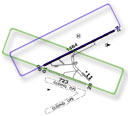Flying Training
Lesson 42: Solo Circuit Consolidation
Saturday 3 February 2007, 4.00pm in Citabria RRW. Instructor: Rob Marshall.
Weather: partly cloudy. Storms over the ranges. The 15-16 knot wind was straight down runway 06.
A busy weekend. Drove Alexander to cricket for 8.30am and stayed a couple
of hours but didn't see him bat.

 Back home to run Angus to soccer registration, then dropped him off and
picked up Cameron and Brendan to take them to softball. From softball we
drove to Nowra where Alexander had a pre-season game against Southern
Branch (which his team won 7-0). On the way there I made time for a flying
lesson, but it nearly didn't happen as thunderstorms were predicted for the
Sydney area. The photos show the storm clouds over Mittagong, and we had a
single stroke of lightning, but it didn't amount to any more than that, and
flying wasn't interrupted. Even gliders were being aero-towed as I took the
photos.
Back home to run Angus to soccer registration, then dropped him off and
picked up Cameron and Brendan to take them to softball. From softball we
drove to Nowra where Alexander had a pre-season game against Southern
Branch (which his team won 7-0). On the way there I made time for a flying
lesson, but it nearly didn't happen as thunderstorms were predicted for the
Sydney area. The photos show the storm clouds over Mittagong, and we had a
single stroke of lightning, but it didn't amount to any more than that, and
flying wasn't interrupted. Even gliders were being aero-towed as I took the
photos.
Most of the flight consisted of circuit after circuit on 06 while I repeated most of the errors of last week, particularly letting the aim point move down in the windscreen, followed by rounding out too high, losing speed rapidly and dropping the aircraft on the runway at a fairly high descent rate. I also had it bouncing from mains to tailwheel a couple of times but recovered quickly (stick back!). Eventually my approach and landing became consistent enough for Rob to trust me with a few solo circuits. The first solo touchdown was not good, which is a pity as it was right in front of Doug waiting at the hold point in his Yak-52. I touched down probably too fast, and/or with the stick not all the way back and, in Rob's words, "skipped" back into the air (anyone less charitable would call it a bounce). I held the stick steady, then brought it back slowly as the aircraft descended again and this time stayed comfortably on the ground.
The next landing was, again in Rob's words, "perfect". I judged the flare better this time, held it off, kept holding it off until the stall warning sounded, and touched down, I believe, on all three wheels. The third landing Rob didn't observe, but I'm going to claim it was like the second!
 The circuits were made more interesting by the fact that ATC had closed for
the day, so we were in CTAF
conditions, and there was another student in a 152 doing circuits on 10. The
diagram (click to enlarge) shows the way the circuits could overlap (though
the green pilot on 10 has left his base turn rather late). The exact
crossover points would obviously depend on the way each pilot flies his
circuit, but generally an aircraft doing circuits on 10 would cross the
mid-point of 06/24, and particular care needs to be taken turning base and
final.
The circuits were made more interesting by the fact that ATC had closed for
the day, so we were in CTAF
conditions, and there was another student in a 152 doing circuits on 10. The
diagram (click to enlarge) shows the way the circuits could overlap (though
the green pilot on 10 has left his base turn rather late). The exact
crossover points would obviously depend on the way each pilot flies his
circuit, but generally an aircraft doing circuits on 10 would cross the
mid-point of 06/24, and particular care needs to be taken turning base and
final.
This is where the CTAF radio procedures help. If each pilot makes a call just before turning downwind, base and final, then the other pilot knows where to look. Although the Citabria is a little faster than the 152, I used these calls to keep behind him in the circuit. This meant slowing down on the downwind leg. I kept him in sight as much as possible, and I'm sure he was doing the same. There was a point (when I was still climbing to circuit height on crosswind and heard him call downwind) that I thought a rear-view mirror might be a useful feature. The diagram shows that as long as his downwind leg crossed runway 06/24 we weren't close, but it's a good reason not to turn crosswind too early when climbing out on 06.
The next lesson will be instruments again, and it will give Rob a chance to check my knowledge of the training area. It will probably be in the Warrior [no it wasn't].

